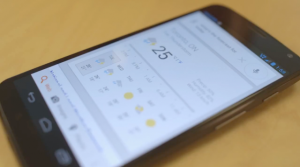Remember Motorola? Once a serious competitor within the mobile phone industry, the company fell behind in the development of touch-based smartphones, allowing manufactures like Apple and Samsung to take the lead. Still, the technical expertise and communication background of Motorola was enough for Google to pay 8.8 billion Euros for it at the end of 2011, buying the whole mobile business area of the company.
However, instead of releasing new Motorola devices, Google chose to remain quiet about this new business acquisition. Instead, Google have since released devices manufactured by external companies such as Samsung (Nexus 10), Asus (Nexus 7) or LG (Nexus 4). Until now. After months of speculation, concrete information has reached the (tech) press about Google’s new smartphone, the Moto X.
The question remains though why has Google bought Motorola for such a high price instead of continuing to use their external manufacturers? The answer comes alongside a new feature which will come with the Moto X: always-on voice and sound recognition with the full support of Google Now (a service we mentioned earlier this year [see article]). Always-on is a technology which Google is fiercely protecting from other mobile competitors and it will be first seen with this Google-made Motorola phone. Since voice recognition itself is nothing new – it is constantly improved and used for apps like Siri (Apple), S Voice (Samsung) or Google (Google Now) – the biggest difference is that this technology will be constantly activated & available on the Moto X. This evolution makes sense for Google as their long term goal appears to be replacing touch controls with voice control.
Simply said, the Moto X microphone will be constantly turned on and listening to its surroundings. Whether this feature could be deactivated has not yet been confirmed nor denied. However, as more and more people use multiple devices often at the same time; watching TV while browsing the web with the tablet and texting via smartphone, this control mechanism could completely change the interaction between devices. For example; whilst one writes an email to their friends to plan an event, they can simultaneously ask the Moto X out-loud what the weather will be like and receive an answer immediately. How far the technology goes and if users will accept an artificial conversation partner will be found out sooner rather than later, as the Moto X could be released as early as August 2013.
Nevertheless, Google is not the only company who wants to find out more about their users behavior by listening or watching. With the new Xbox One from Microsoft recently announced, the Kinect device of the console will constantly watch and listen to its surroundings. At the official announcement event Microsoft almost completely controlled the console via voice, though instant voice control may hide hidden costs. For instance, Microsoft has reportedly filed a patent which allows them to charge more money for a movie if more than one person is watching the movie.
On a final note, it will be interesting to see how external companies can benefit from this technology. For example, search engine marketing is good way to create awareness for products and services, but if users access a search request only via voice without looking at a screen, traditional PPC or SEO advertising will immediately become less effective or even obsolete. However, with Google making so much money from advertisers, they will no doubt roll out new advertising methods if voice recognition prevails.
